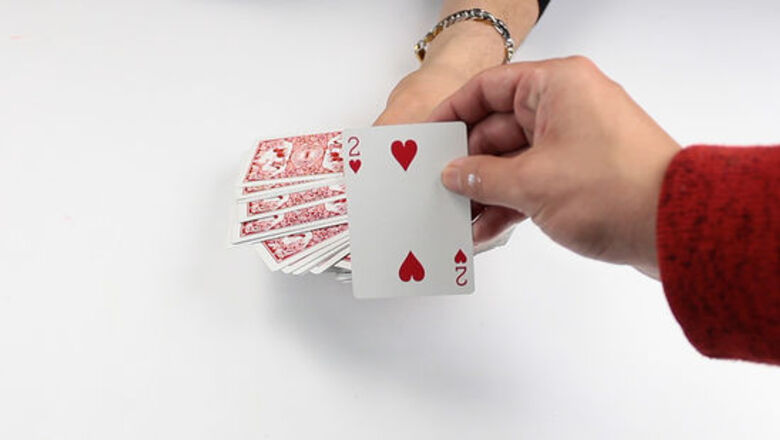
views
Finding a Picked Card
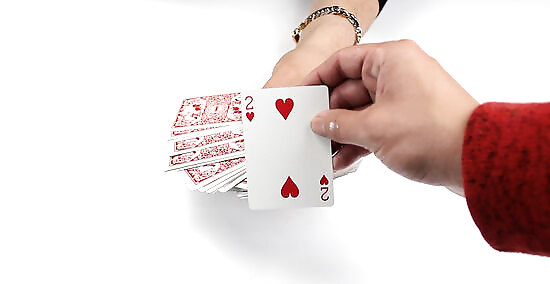
Ask a volunteer to pick any card out of the deck. Hold a deck of cards face-down and fan them out. Ask your volunteer to choose one card at random and take it out of the deck. Be patient, because the longer you give the volunteer to pick a card, the more confident they will become that you won't be able to guess it. Shuffle the cards first so the audience knows that they really are in a random order. Look away from the cards as the person picks their card to make the trick more convincing.
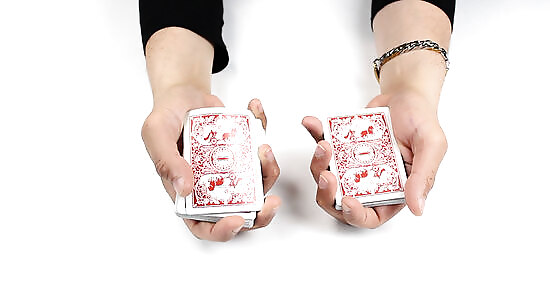
Cut the deck into two stacks. Split the cards in a slightly different place from where the audience member drew their card. Hold one stack in the right hand and the other in your left hand.
Tell the volunteer to place the card on the pile in your left hand. Give your volunteer enough time to look over and memorize the card before putting your left hand out for them. Let them set the card face-down so you can continue. Avoid rushing the volunteer since the audience may think you've memorized the card beforehand.

Look at the bottom card of the pile in your right hand. As your volunteer puts their card back, slightly bend the cards in your right hand to see which one is on the bottom. Remember the value and suit of the card since the card the person picked will be right next to it.
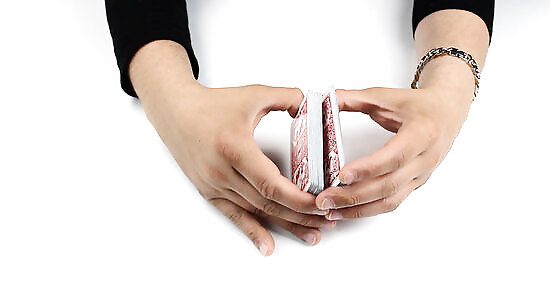
Sandwich the picked card between the two piles. Set the pile from your right hand on top of the pile that’s in your right hand. After that, make sure you don’t shuffle or mix up the cards anymore since you may lose the one your volunteer selected.
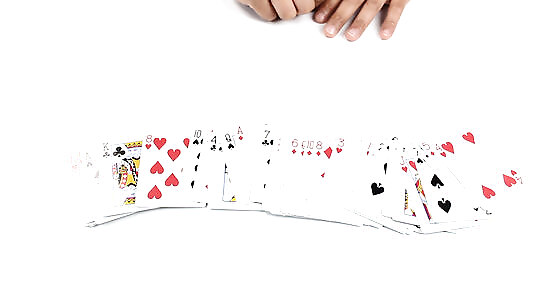
Spread the cards out and find the bottom card of the right pile. Turn the deck face-up and set the pile down on the table and fan them out on the table so they’re all visible. Quickly try to find the bottom card you memorized earlier, but try not to make it obvious to your audience that you’re looking for it. Avoid spreading the cards quickly and sloppily. You might accidentally ruin the reference card's position, throwing off the entire trick.
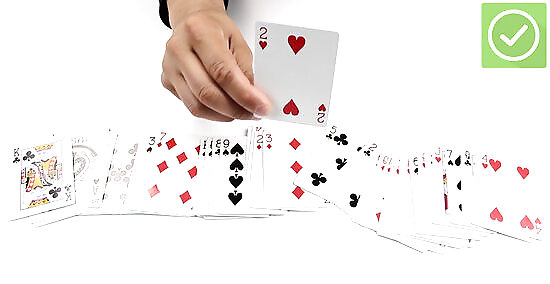
Choose the picked card and reveal it to the audience. Take a few seconds to pretend like you’re concentrating really hard. In reality, the card the volunteer picked will be right on top of the card you memorized. Pick the card out of the spread and ask the volunteer, "Is this your card?" The audience will be stunned that you were able to locate the card so fast.
Bringing a Card to the Top
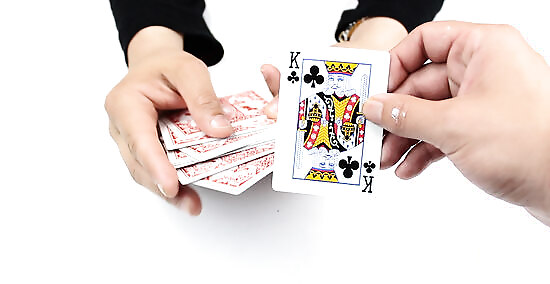
Ask someone to pick a card from the deck. Fan a deck of cards in your hand and tell the person, “Pick a card, any card!” Once they choose one, tell everyone to look at it without showing it to you.
Put the selected card under the top card of the deck. Take the card back from the person. Hold the cards out of sight or behind your back so your audience doesn’t see them. Gently squeeze the sides of the deck’s top card to lift it slightly. Slide the selected card underneath the first card so it’s hidden. If someone protests about you hiding the cards, say that it’s “part of the suspense,” or, "a magic moment." Try practicing with a deck of cards when you don’t have an audience so you’re able to master the movement beforehand.
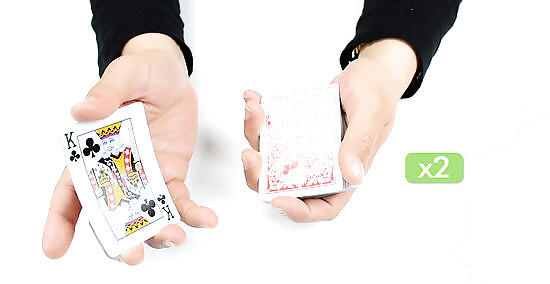
Take the top 2 cards off the deck at the same time to reveal the selected card. Carefully riffle through the cards until you only have the top 2 selected. Keep them lined up so it only looks like a single card. Then, just flip them over to only show the bottom card.
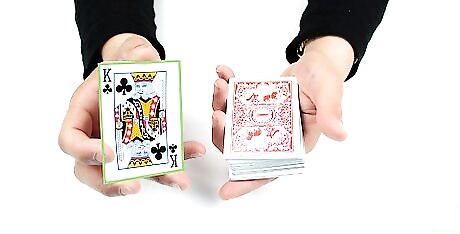
Ask the audience "Is this your card?" After they confirm, put the pair back on top of the deck face-down. That way, the selected card is still the second card in the deck.
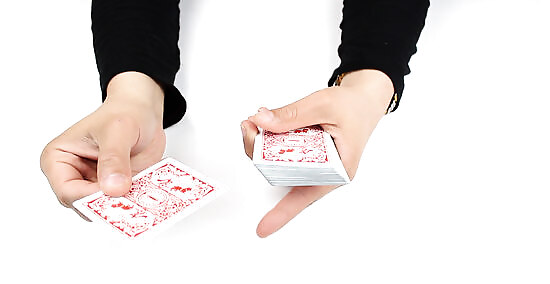
Place the top card anywhere in the deck. Lift up the top card and push it into the middle of the deck. Remember, the selected card is now on top, but the audience will think you moved their card to a random spot.
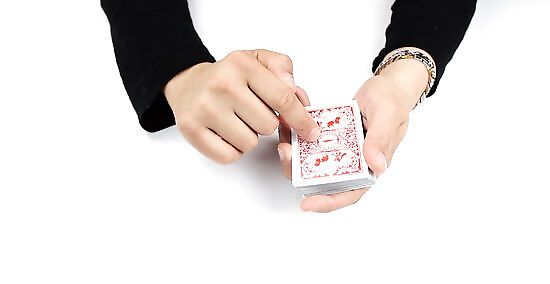
Explain that you will bring the selected card back to the top. Tell your audience that even though the card seems lost, your magic will make it come back to the top of the deck. Make a fancy gesture with your hands, like waving them over the deck or snapping your fingers, to really play into the dramatic aspect.
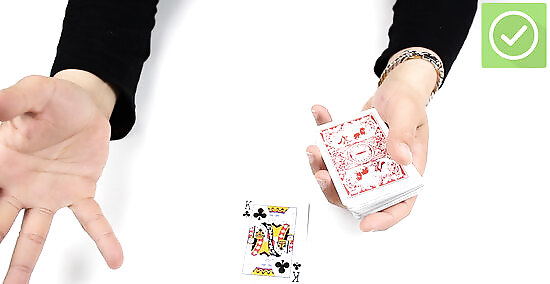
Reveal the top card while saying "Voilà!" Your audience will be amazed that the top card was the one they selected. If someone asks how you did it, avoid telling them and say something mysterious like, “A magician never reveals their secrets.”
Guessing a “Random” Card

Glance at the bottom card of the deck before holding the cards face-down again. Start with cards in a single stack. Make sure it's just a quick peek that no one will notice. Make sure you remember the suit and value of the card so you’re able to tell it to your audience during the big reveal.
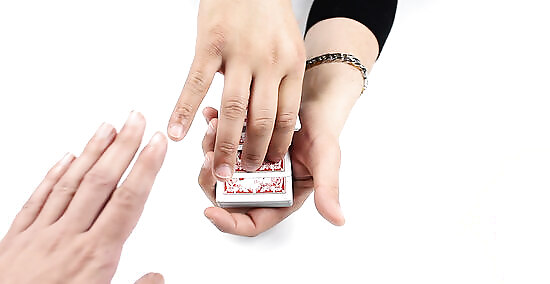
Riffle through the cards and have someone tell you when to stop. Hold the deck face-down in one hand. Pull the top cards towards you using the fingers on your other hand. When the volunteer tells you to stop, take the cards you pushed back off of the stack. Letting the audience member say stop makes them think they’re in control of the trick even though they’re not. If you’ve gone through more than about a quarter of the deck without being stopped, slow down a bit and joke around to get someone to stop you. If no one says stop and you reach the bottom, just start over and playfully tell them to say it sooner this time.

Slide cards off both the top and bottom of the deck in one motion. Squeeze the sides of the pile of cards in your hand. Press your index and middle finger down on the card on top of the pile and your thumb on the bottom card. Quickly pull the top and bottom card out at the same time so it looks like you only took one card from the deck. Make sure the edges of the cards you pulled line up so it doesn’t break the illusion.
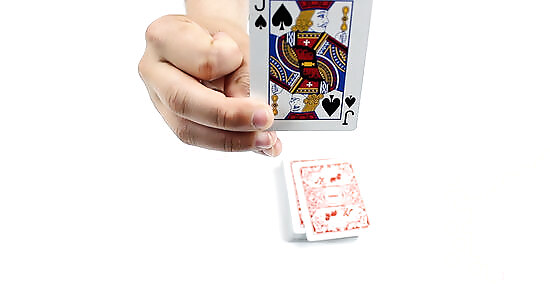
Show the audience the card and announce what it is without looking at it. Hold the bottom card out for everyone to see, but close your eyes. Tell the audience that this was the card where they chose to stop and it could have been any card. Then, state what card you revealed, and your audience should be bewildered that you guessed correctly. Try stating the card as a question, like “Was the card you selected the Jack of Spades?”
Simple Prediction with Probability

Ask an audience member to shuffle a deck of cards. Encourage the audience member to shuffle it as many times as they like. It doesn’t matter how well they mix up the cards since this trick is based on probability rather than misdirection.
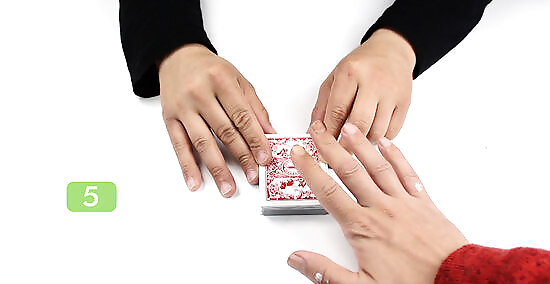
Ask the audience member to name 2 different card values. Tell your audience that you’ll magically put 2 cards next to each other without ever touching the deck. Rather than have them specify the suit, only have them name the values of the cards instead. When the audience member says a card value, they’re actually naming 4 different cards since the suit wasn’t specified. With 2 card values, the audience member is picking 8 different cards and there’s a 21% chance they’ll be next to one another somewhere in the deck.
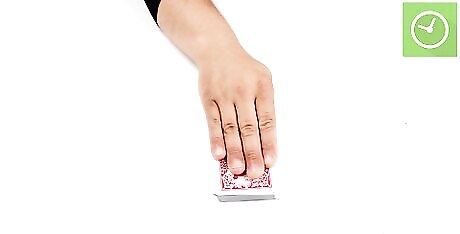
Position your hand over the top of the cards and concentrate hard. Tell your audience they should concentrate with you as you wave your fingers above the deck. Wait a few seconds before snapping and continuing the trick to build the illusion that you’re using magic to move the cards. Try not to touch the cards when you’re concentrating to make the illusion look more believable.
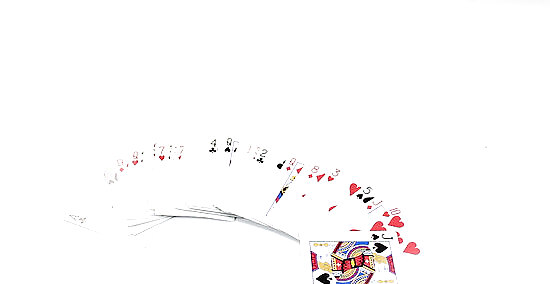
Tell the audience member to flip over and fan through the deck of cards. Make sure they spread the cards out for everyone to see them. Let them move the cards until all the values are visible.
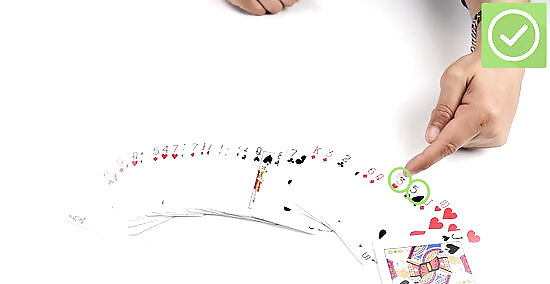
Point out where the 2 selected card values are next to one another. Even though the cards are shuffled, there’s about a 20% chance that the values the person said at the beginning of the trick are next to one another. If there’s a card or two in between the selected values, tell your audience they didn’t concentrate hard enough and try it again. Avoid actually touching the cards when you find the selected cards. Otherwise, the audience may think you've secretly placed a hidden card next to another.
Blind Prediction with a Handkerchief
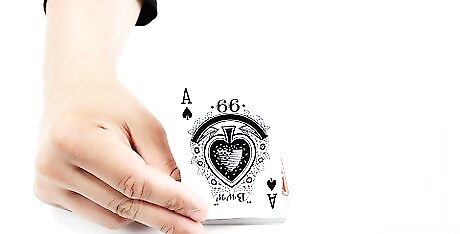
Look at the top card of the deck and memorize it. Before you’re in front of an audience, peek at the top card. That way, you can take your cards out and go right into the trick to make it more convincing.
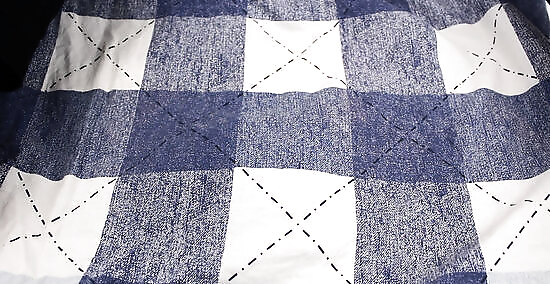
Set the deck face-down with a handkerchief over it. Tell your audience that you’re going to predict what card is on top of the deck without even looking at it. Make sure your audience sees the cards facing down before you place the handkerchief over them. For the best effect, make sure the handkerchief isn’t see-through.
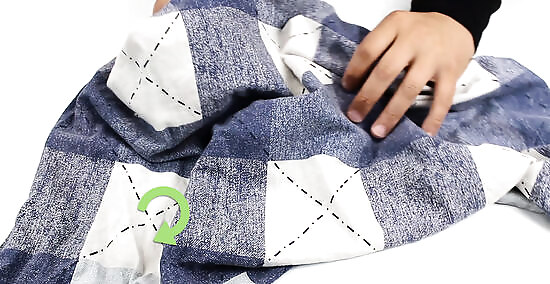
Turn the deck face-up as you place the handkerchief over it. At the same time you’re fluffing up the handkerchief and getting it in place, use your other hand to turn over the deck. Drop the handkerchief over them right away so they’re concealed from the audience. Practice placing the handkerchief and flipping the cards in one fluid motion so it looks effortless when you perform it in front of people.
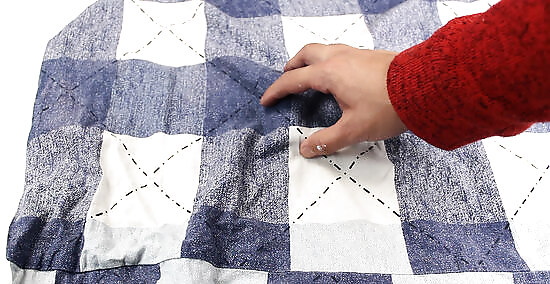
Ask a volunteer to cut the deck in half while the handkerchief is on top. Ask the person to slowly lift half the deck up and place it next to the other half. Be sure you keep track of which is which and keep the cards concealed. The person cutting the cards thinks they are holding the top half of the deck, but they actually have the bottom half since you flipped the cards. That means the top card you memorized hasn’t moved.
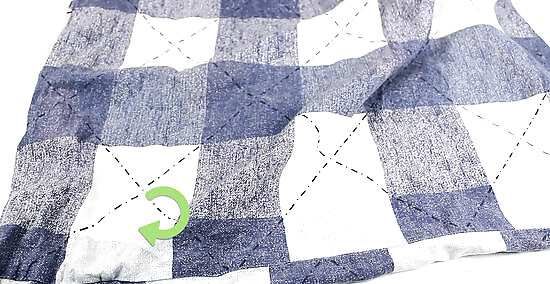
Pull the top half of the deck out while turning the cards face-down. Reach under the handkerchief and grab the original stack of cards. As you’re pulling them out, quickly turn the entire stack over so the cards are face-down again. Only remove the top half of the deck. Leave the handkerchief over the bottom half of the deck since it’s still face-up. Try to use fancy gestures to distract the audience from the hand you’re using to flip the cards over.
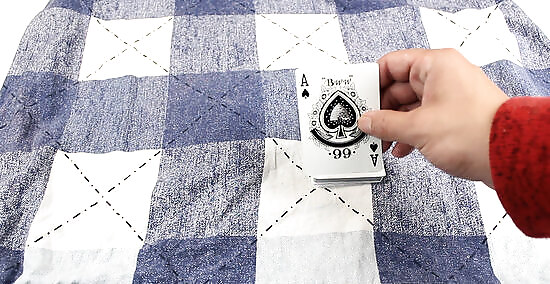
Reveal and name the top card without looking at it. Ask an audience member to pull the top card from the stack you pulled out and show it to everyone except you. After a few seconds, say the name of the card you memorized earlier and listen as people gasp in disbelief. The audience will think the card came from the middle of the stack, even though it was always just the top card from the deck. While everyone is left wondering how you did it, reach under the handkerchief and turn over the other stack of cards in case someone wants to inspect them.
The Four Appearing Aces

Place the 4 aces on top of the deck. Take the aces out ahead of time and set them on top of the deck so your spectators don’t see you prepare. Then, bring the deck out of your pocket and transition directly into the trick without letting anyone shuffle it. Get immediately into the trick so your audience doesn’t ask about the cards. Ask, "Hey, do you guys want to see a magic trick?" and then transition right into it. The more fluid and natural you make it seem, the less the audience will question why you didn’t shuffle.
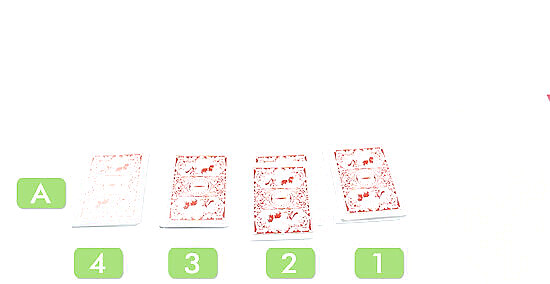
Split the deck into 4 even piles. Slowly drop cards from the bottom of the deck onto the table. Distribute the piles from left to right so that the fourth pile with the aces on top is on your far right. It’s okay if you don’t count the cards out perfectly as long as they look about even. Don't focus too hard on the fourth pile. Try to distract your audience and use misdirection when you’re doing a card trick so the audience doesn’t catch on to where the aces really are.
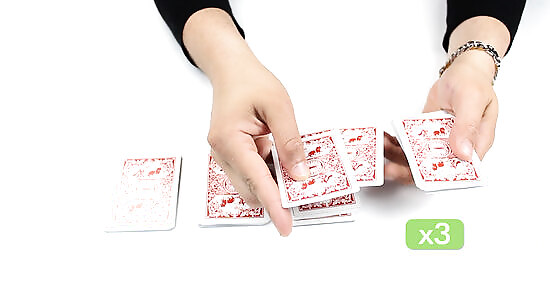
Move the top 3 cards of the first pile to the bottom. Explain that you’re looking for the aces and that you magically know where they are. Since the aces aren’t even in the first pile, it looks like you’re shuffling the deck and randomizing cards.
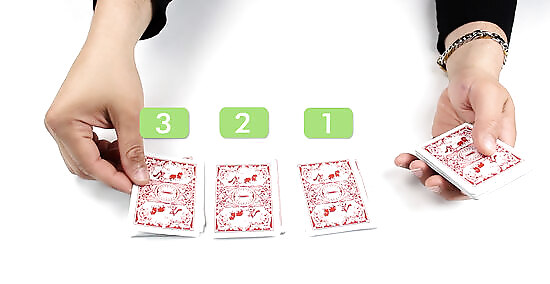
Deal the top 3 cards of the first pile to the tops of the other piles. Deal 1 card to each of the piles face-down. After you finish dealing the 3 top cards of the first pile, set it back down on the table.
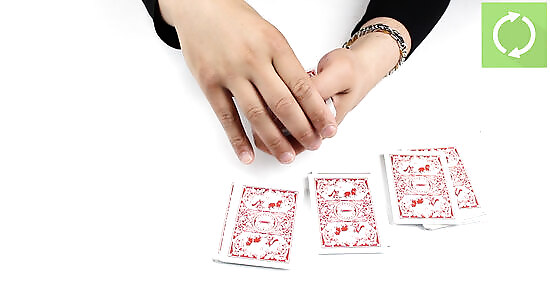
Move the top cards of each pile the same way as the first one. Go on to the second pile and move the top 3 cards to the bottom. Then, deal the next 3 cards to the tops of the other piles. Repeat the process for the third pile and end with the fourth, which has the aces. When you deal cards from the other piles, you place 3 extra cards on top of the fourth pile. When you finally repeat the steps for the last pile, you move the 3 cards you’ve just placed so you deal 3 aces out to the other piles.
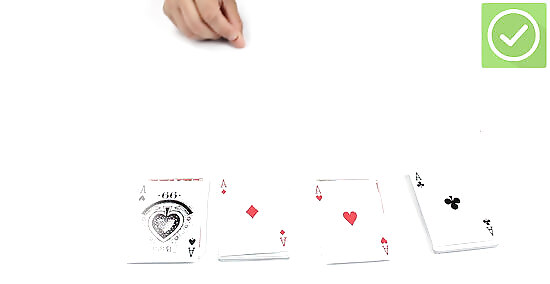
Turn over the top card of each pile to reveal the 4 aces. Tell your audience that even though all the cards were randomized, you still found all the aces and brought them to the top of each pile. Then, slowly reveal each card. If the audience reacts with disbelief, offer to perform the trick again. Once you perfect this trick, switch it up by giving an audience member instructions to perform it themselves. Direct them through cutting the deck and moving cards around the piles. The audience will believe your trick more because you didn’t have to touch the cards for it to work.
Eights End Up Together
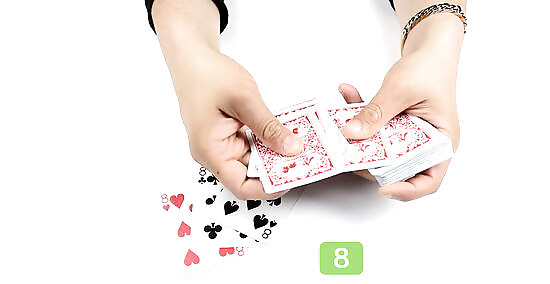
Position the 8s in the deck before you do the trick. Take out the four 8s from the deck. With the deck face-down, put one 8 on top of the stack. Count 9 cards off the top of the stack and place the next 8 on the pile. Turn the deck over and put the remaining two 8s as the 8th and 9th cards from the bottom. Make sure you don’t shuffle the cards before you do the trick, or else you’ll lose the card positions.
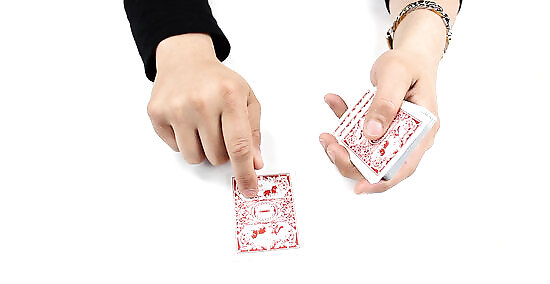
Pull the second 8 out of the deck and set it face-down to start the trick. Tell your audience that you’re going to magically pull out a card that predicts the cards you’ll reveal later in the trick. Hold the cards face-down and fan the cards from one hand to the other. Secretly count each card. When you reach the tenth card, keep your finger on it but keep going for a few more cards. Then, pull it out and place it face-down on the table. Tell your audience this is your prediction card. Pulling out extra cards makes your prediction look more random and impressive.
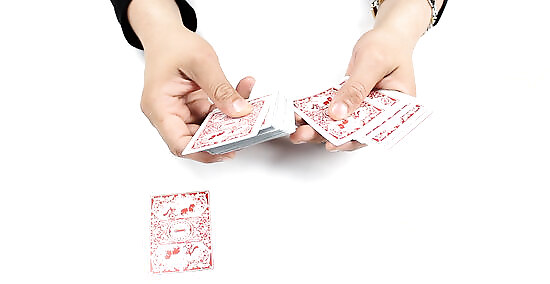
Flip the deck over and go through cards until the audience says stop. Turn the deck over and start pulling cards off the deck one at a time. While you’re doing that, tell the audience that you’re going through the cards and that you want them to tell you when to stop. Just be sure that you’re past the two 8s by the time you say the word “stop” so they for sure end up in the same pile.

Create two piles when the spectator tells you to stop. Stop putting cards down into the pile and turn it over. Take the pile still in your hand and flip it face-down. Then set it to the left of the other pile. The pile on the left has the 8 on top while the pile on the right now has the 8s in the 8th and 9th position in the deck.
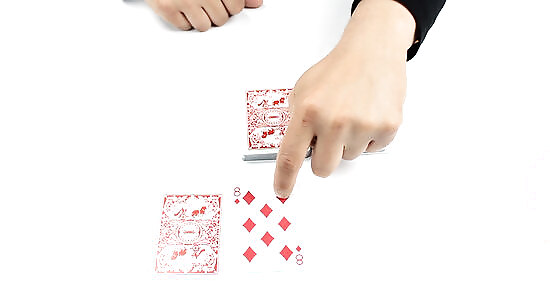
Flip over the top card of the pile on the left. Tell the audience that the card you reveal from this pile determines how many cards you need to take off the pile on the right. Slowly slip the card over and tell the audience that it’s an 8.

Count out 8 cards from the bottom of the deck on the right. Continue talking to the audience and tell them since you revealed an 8, you must remove 8 cards from the stack on the right. Take the cards off one at a time so one of the 8s ends up on top of the new stack.
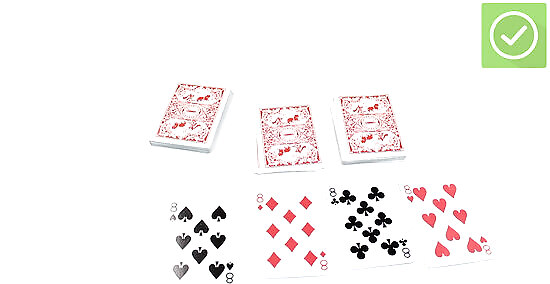
Reveal the other 8s. Turn over the top card of the pile you just put on the table to reveal the second 8. Then, turn over the top card on the other pile and reveal another 8. Finally, after building up a bit of anticipation, dramatically flip over your prediction card that’s been on the table the whole time to reveal that you made a correct prediction!




















Comments
0 comment